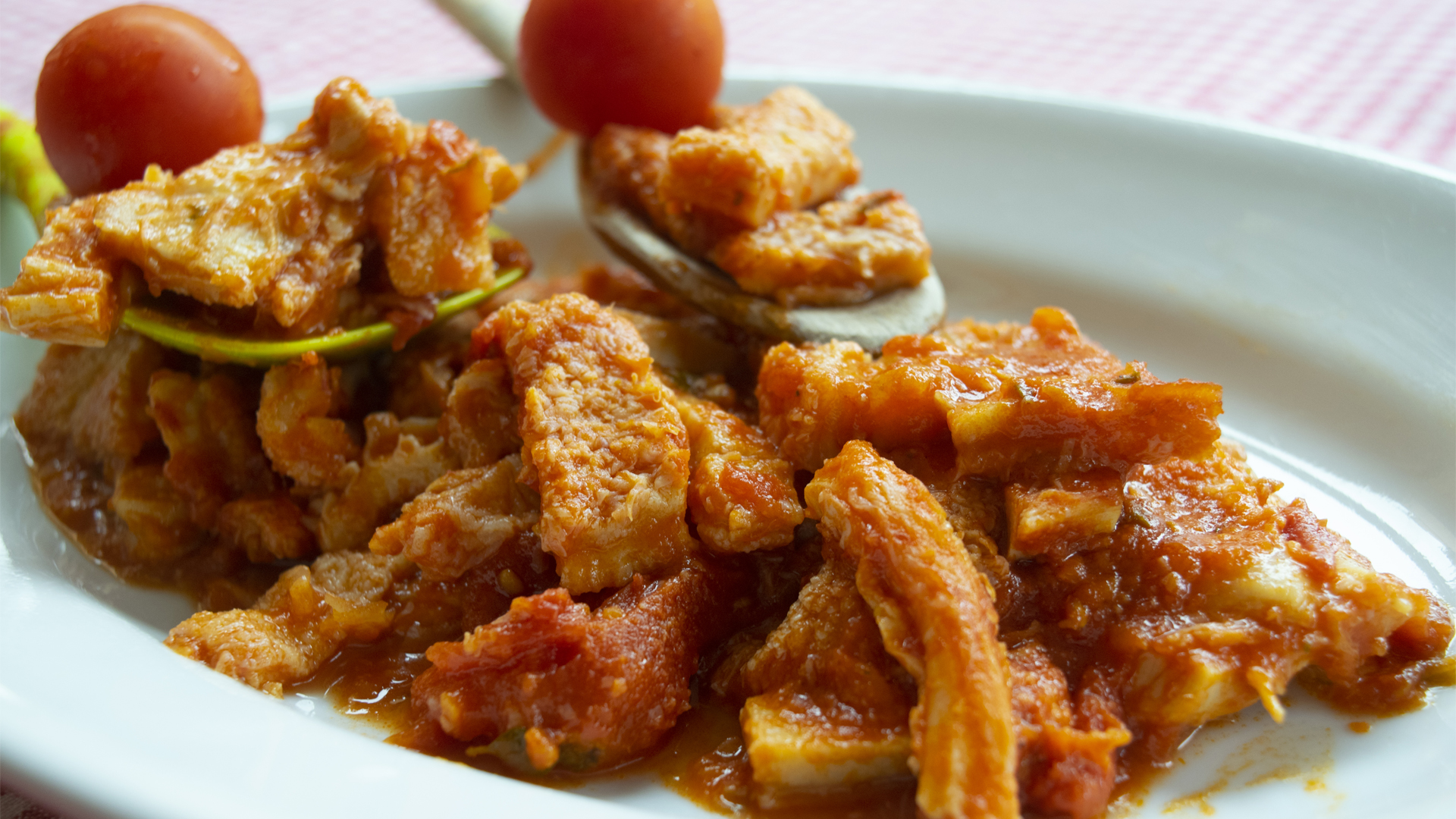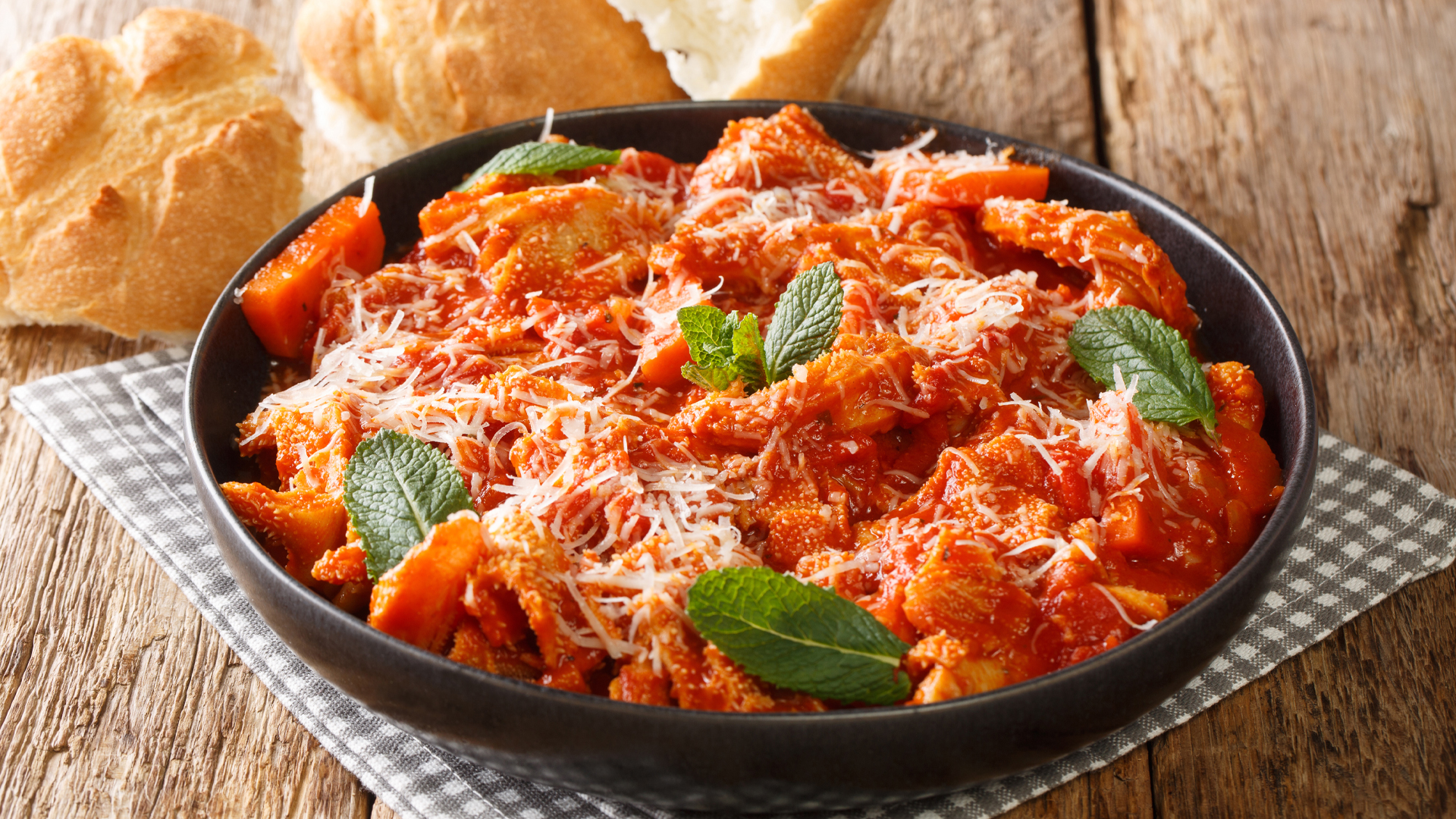World Tripe Day is October 24th.
Tripe and other cuts of offal—the organs and entrails of a butchered animal — are making a culinary comeback since they are inexpensive, and excellent protein sources. And “nose-to-tail” cooking has worked its way into our consciousness as a tangible way to reduce food waste since offal comes from parts of a butchered animal that are considered scraps and discarded. In honor of World Tripe Day, here’s all you need to know about one of Italy’s favorite foods!
What Exactly is Tripe?

Cattle tripe. Tripe is a type of edible lining from the stomachs of various farm animals (Photo Credit: Getty Images)
Trippa, or tripe, is the edible stomach lining of cows! You may have seen it in the supermarket, sold as Beef Honeycomb Tripe, although tripe can also be procured from the stomachs of goats, sheep, and pigs. Honeycomb tripe comes from the cow’s second stomach chamber and derives its name from its appearance —it resembles the hexagonal cells of a bee’s honeycomb. When compared to blanket tripe—a flat sheet of intestine from the first stomach chamber or book tripe from the third stomach chamber, and whose stacked folds look like the pages of a book, honeycomb is prized for its mild flavor and meaty texture that is perfect for low and slow braising. While it cooks, honeycomb tripe absorbs the flavors in the pot like a sponge, and in the process, its texture is rendered silky smooth, and succulent.
Cucina Povera
The Italian tradition of eating tripe has its roots in the centuries-old culinary tradition known as cucina povera—the practice of using each part of an animal to feed a family, preventing any part from going to waste. It was often the offal—the organs and entrails of a butchered animal— that was rejected by wealthy merchants. Instead, farmers relied on these cuts of meat, using slow cooking techniques to layer flavor, and create pleasing textures.
Matthew Moschella, executive chef and co-owner of Corto in Jersey City Heights, NJ, an Italian restaurant lauded for cucina povera cooking, explains: "Tripe is a seemingly undesirable, and often underutilized, but its rich, silky texture and the opulent mouthfeel is the result of the care that a person puts into cooking it." A dish like tripe reflects the heart of cucina povera cooking. "You take a cut of animal that is "off-putting" and transform it into something comforting!" says Moschella. And, he says, "Tripe not only provides nourishment, but it pays homage to the animal and the farmer."
Tripe Traditions in Italy
Tuscan and Roman regional cooking incorporate tripe into several classic dishes, among them Rome's la pajata, (la pagliata, in standard Italian). This tripe dish makes use of the stomach lining of milk-fed only calves. The undigested mother's milk in the intestines (called the chyme) is left in the tripe when it is cleaned and prepared for cooking. The chyme coagulates as the tripe cooks in a rich tomato sauce traditionally served over rigatoni (or grilled and served as pajata arrosto), rendering a thick and creamy sauce.
Another tripe preparation is Trippa Alla Romana—beef honeycomb tripe redolent with fresh mint and Pecorino Romano cheese. "The accompanying flavors —tomato, mint, and pecorino cheese are approachable and aren't items you need to buy for one recipe, then have them sitting in your pantry forever!" says Chef Moschella, who favors this preparation. "Through patience and intentional technique, you can make something completely different from the base ingredients.”
Trippa alla Romana

Trippa alla Romana or roman style tripe with fresh tomatoes and pecorino cheese (Photo Credit: Getty Images)
Adapted from Cooking the Roman Way
Serves 4
Here is an easy home cook’s recipe to get cooking with trippa. You’ll need a few ingredients; among them, says Moschella are “patience and love.” Look for bleached tripe. It is freer from grit, and the cleaning process is less labor-intensive. Chef Moschella advises keeping the temperature “impossibly low” so that you render silky tripe. Also, slicing the tripe into thin strips after parboiling shortens the cooking time, and the smaller pieces thoroughly absorb the tomato sauce flavors.
Ingredients:
- 2 ½ pounds bleached honeycomb beef tripe (it will look white)
- 2 tablespoons extra-virgin olive oil
- 1 celery rib and leaves, finely diced
- 1 carrot, ends trimmed, and peeled, finely diced
- 1 large onion, finely diced
- ¼ teaspoon crushed red pepper flakes
- 1 fresh whole bay leaf
- ½ cup dry, crisp white wine, such as Sauvignon Blanc
- 1 (28-ounce) can of whole peeled tomatoes, and their juices
- 1 tablespoon kosher salt
- 1 teaspoon freshly ground black pepper
- 4 tablespoons finely chopped fresh mint
- 1 ½ cups freshly grated Pecorino Romano
Directions:
- Place the tripe on a cutting board and use a paring knife to remove any visible fat. Transfer it to a colander and thoroughly wash it under cold running water for 5 minutes, rinsing and repeating, until there is no hint of chlorine.
- Fill a large pot with water and bring it to a boil. Add the tripe and boil for 1 hour.
- Drain the tripe, then transfer it to a cutting board, and slice it into thin strips about 1-inch wide.
- Heat the olive oil in a large pot over medium heat. Once it is shimmering, add the celery, carrot, onion, and chili flakes, and cook, until the vegetables begin to soften, about 5 minutes. Next, add the tripe and bay leaf, and cook, until the vegetables begin to brown, about 3 minutes. Add the wine, and cook, raising the heat, if necessary to allow the wine to evaporate, for 1 to 2 minutes.
- Add the tomatoes and their juices — (using your hands to squish them into the pot), the salt and pepper, and stir. Bring the mixture to a boil, then lower the heat to a very low simmer, cover with the lid, and cook for 30 minutes.
- Stir the mint into the pot and turn off the heat. Remove and discard the bay leaf. Sprinkle in 4 tablespoons of the pecorino and let sit for 2 minutes before serving with the remaining pecorino on the side.
Theresa Gambacorta
Theresa Gambacorta is a writer and cookbook co-author. Her writing has appeared in such titles as La Cucina Italiana, Spin Magazine, Men's Fitness, Muscle and Fitness, and Centennial's special interest publications. She is the co-author of chef Joey Campanaro's Big Love Cooking (Chronicle, 2020), chef Nasim Alikhani's Sofreh (Knopf, 2023), and the forthcoming vegan cookbook, Eat What Elephants Eat by activist Dominick Thompson (Simon Element, 2024).

